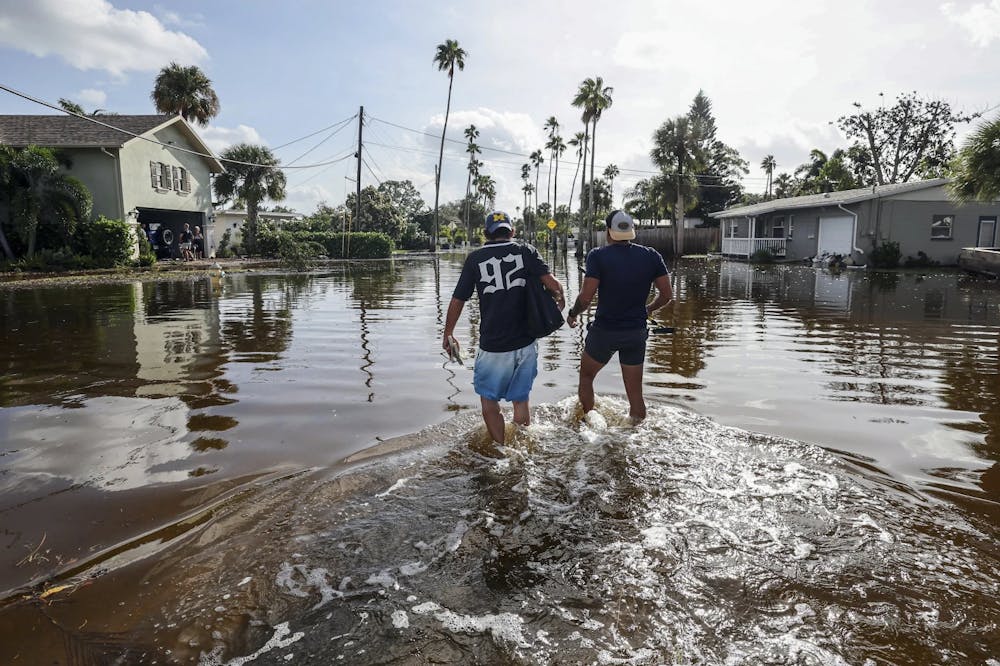Hurricane Helene hit the Big Bend area of Florida on Sept. 26 and snaked its way 400 miles up to North Carolina where the majority of the damage occurred.
The hurricane claimed more than 200 lives across the Southeast through flash flooding and associated damage. Strong wind gusts damaged property and blew trees and power lines down in a swath from the Gulf Coast to the North Carolina mountains, the National Weather Service reported.
Helene reached peak intensity with winds of 140 mph. More than half of the deaths were in North Carolina, where entire communities were uprooted and devastated by the deadliest mainland storm since Katrina in 2005, which killed more than 1,800 people, according to the National Oceanic and Atmospheric Administration.
Ninety-two persons are still unaccounted for in North Carolina, weeks after Hurricane Helene devastated the western part of the state, Gov. Roy Cooper said on Oct. 15. He warned that the number could change as reports of missing people are resolved.
Tens of thousands of people have no running water in North Carolina, which has seen some of the severest impacts of the storm, particularly in the mountainous area of Asheville.
In North Carolina’s Buncombe County alone, home to the city of Asheville, more than 35 residents have died and 600 are missing.
Ashville is also home to monthly Christian news magazine, WORLD, whose offices were severely affected. Water rose an estimated six feet inside the structures, one of which is a single-story former bank renovated to hold WORLD’s member services and studios for media production.
WORLD’s staff was affected by the flash flooding, as well.
“The house I lived at flooded, and I had to evacuate,” Jo Huebscher, associate producer at WORLD, said. “The majority of my things are gone, but I have a lot of support, praise the Lord.”
The correctional facilities in North Carolina had to accommodate for the damage caused to their facilities, as well. According to the North Carolina Department of Corrections, 800 convicts were relocated on Wednesday owing to a shortage of power and running water in their institutions. Over 2,000 convicts were transferred from other jails earlier this week.
Experts estimate that 40 trillion gallons of water fell on the six-state region, enough to fill 60 million Olympic-sized swimming pools.
Kamal Amin has lived in Saint Cloud, Florida, since 2014, and has experienced many hurricanes due to his location.
“It was nothing out of the ordinary,” the Florida resident said. “(Hurricane) Irma wiped out my backyard fence, and I had lost power for 10 days, so I wasn’t sweating Milton.”
The eye of the hurricane passed over the Orlando region around 2-3 a.m. and did minimal damage to his house besides some panels coming off his fence. Electrical power was lost as well from 4:30 a.m. to 5 p.m. on October 26. The neighboring town of Kissimmee was devastated by flooding though, with trees uprooted, roofs destroyed and power lines down for more than three days, Amin said.
Amidst the chaos, a baby was born in a hurricane shelter in Pinellas County, Florida county officials said.
"We had a beautiful baby girl that was born in one of our shelters," Cathie Perkins, director of the county's emergency management team, said. "Just beautiful to see that new life in the middle of all of this destruction."
The response to the hurricane was immediate.
Speaking in Ray City, Georgia, U.S. President Joseph Biden told residents, “I see you, I hear you, I grieve with you, and I promise you we have your back.”
The president has approved federal disaster relief funds for survivors in Florida, Georgia, North Carolina, South Carolina and Virginia.
More than 6,700 Army and Air National Guard members from 16 states are helping with the on-the-ground response, the national Guard reported.
U.S. Homeland Security Secretary Alejandro Mayorkas cautioned earlier this week however, that if another storm hit the U.S. in the coming months, the Federal Emergency Management Agency (FEMA) would struggle to provide help.
According to Mayorkas, the Biden administration has supplied more than 8.8 million meals, 7.4 million liters of water, 150 generators and 225,000 tarps to the region.
Hurricane Helene was followed closely by Hurricane Milton which made landfall as a Category 3 storm on Oct. 9, near Siesta Key, Florida, a barrier island next to Sarasota. Now a post-tropical cyclone, Milton is expected to continue weakening over the next several days.
FEMA Administrator Deanne Criswell said on October 10 that Milton’s impact was not as destructive as feared.
“We did not have the extreme impacts of the worst-case scenario that we prepared for, but there’s still so many people that have been impacted by this,” she said at a press briefing in Sarasota.
She said the 38 twisters that touched down in the state cause “significant damage to a level that Floridians have not seen from tornadoes.”
On October 10, she toured flooded roads and debris, some of which was left from Hurricane Helene, she said.
The Florida Division of Emergency Management has declared a Level 1 emergency response for Tropical Storm Milton. Multiple authorities are securing sites, preparing vehicles and strengthening infrastructure. The Florida Fish and Wildlife Commission, Department of Health and Highway Patrol are ready to rescue and transport patients.
Transportation and debris management activities are underway, and state departments are assisting businesses, employees and consumers in dealing with Hurricane Helene and its aftermath.




